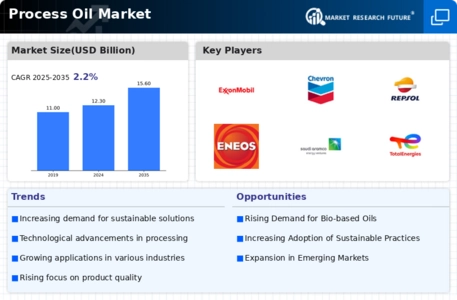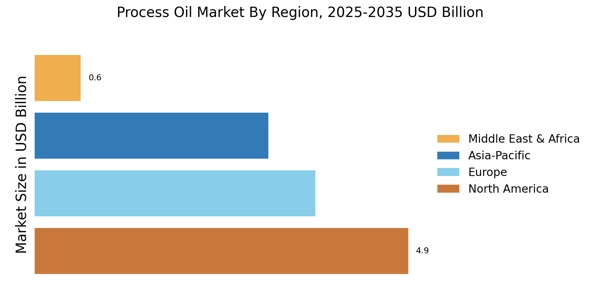Expansion of the Chemical Industry
The Process Oil Market is significantly influenced by the expansion of the chemical industry. As chemical production increases, the demand for process oils as solvents, carriers, and additives is expected to rise correspondingly. In 2025, the chemical industry is anticipated to grow at a rate of 5% annually, leading to an increased consumption of process oils. This growth is particularly evident in regions where chemical manufacturing is a key economic driver. The versatility of process oils in various chemical applications, including plasticizers and surfactants, positions them as indispensable components in the production process. Therefore, the expansion of the chemical industry is likely to create substantial opportunities for the Process Oil Market, fostering innovation and the development of new oil formulations.
Technological Innovations in Oil Production
The Process Oil Market is benefiting from technological innovations in oil production processes. Advances in extraction and refining technologies are enabling the production of higher quality process oils with improved performance characteristics. In 2025, it is anticipated that the adoption of advanced refining techniques will increase by 20%, leading to a more efficient production process. These innovations not only enhance the quality of process oils but also reduce production costs, making them more competitive in the market. As manufacturers leverage technology to optimize their operations, the Process Oil Market is likely to experience accelerated growth, driven by the introduction of innovative products that meet the evolving needs of various industries.
Rising Demand for Process Oils in Manufacturing
The Process Oil Market is experiencing a notable increase in demand driven by the manufacturing sector. Industries such as automotive, textiles, and rubber are increasingly utilizing process oils for their lubricating and processing properties. In 2025, the demand for process oils in the automotive sector alone is projected to reach approximately 1.5 million tons, reflecting a compound annual growth rate of around 4.5%. This growth is attributed to the need for enhanced performance and efficiency in manufacturing processes. As manufacturers seek to optimize production and reduce costs, the adoption of high-quality process oils becomes essential. Consequently, this trend is likely to bolster the overall growth of the Process Oil Market, as companies invest in advanced formulations to meet evolving industry standards.
Increased Focus on Product Quality and Performance
The Process Oil Market is witnessing a heightened focus on product quality and performance, driven by consumer expectations and regulatory standards. Industries utilizing process oils are increasingly prioritizing high-performance formulations that enhance product durability and efficiency. In 2025, it is estimated that around 60% of process oil consumers will prefer premium quality oils, which are perceived to offer better performance characteristics. This shift is prompting manufacturers to invest in research and development to create superior process oils that meet stringent quality benchmarks. As a result, the emphasis on product quality is likely to propel the growth of the Process Oil Market, as companies strive to differentiate their offerings in a competitive landscape.
Regulatory Compliance and Environmental Considerations
The Process Oil Market is significantly shaped by regulatory compliance and environmental considerations. Stricter regulations regarding emissions and waste management are compelling manufacturers to adopt more sustainable practices. In 2025, it is projected that approximately 30% of process oil production will be derived from renewable sources, reflecting a shift towards eco-friendly alternatives. This trend is driven by both regulatory pressures and consumer demand for sustainable products. As companies seek to align with environmental standards, the development of bio-based process oils is gaining traction. Consequently, the focus on regulatory compliance and sustainability is likely to influence the growth trajectory of the Process Oil Market, as businesses adapt to changing market dynamics.


















Leave a Comment